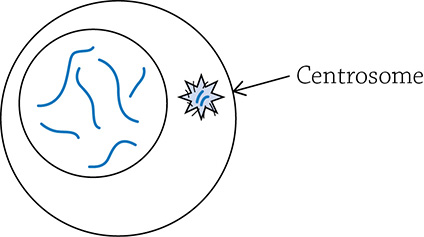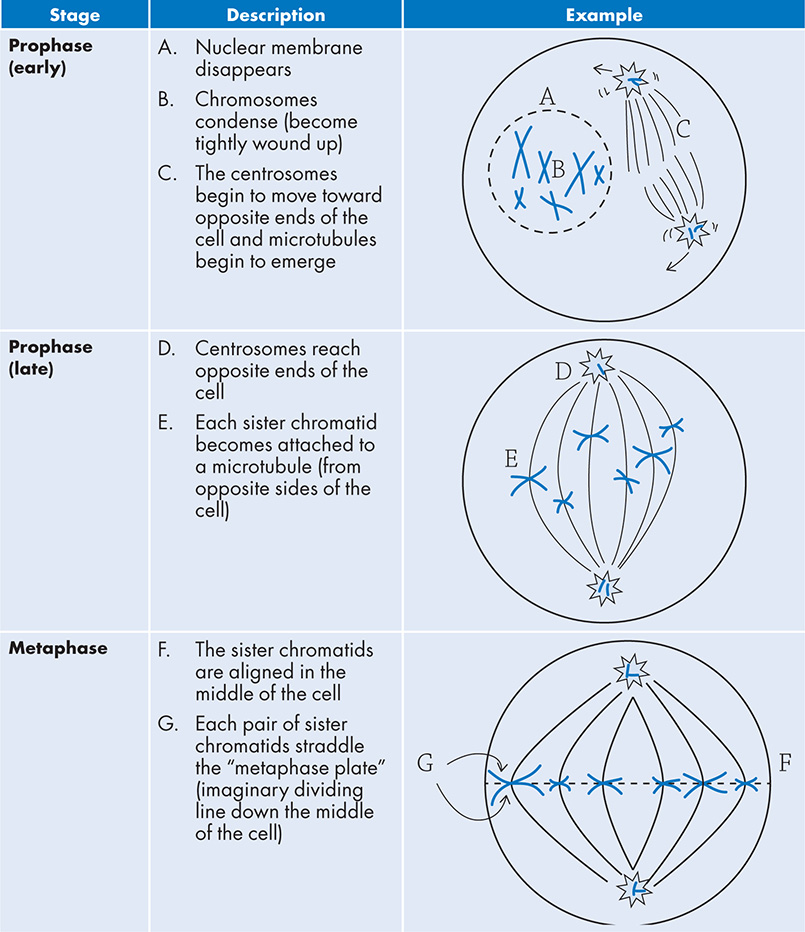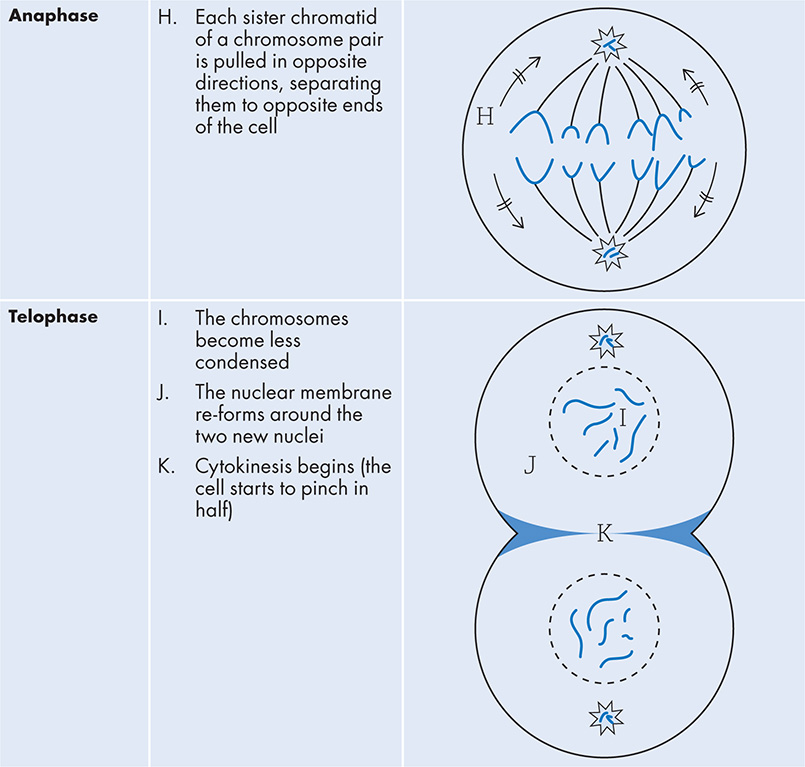12 The Cell Cycle and Mitosis
We just learned about DNA and how it’s copied. But when, exactly, does that occur in a cell’s “lifetime”? Once a cell replicates its DNA, then what? Once the genome is copied, is there more than one way to divvy it up amongst daughter cells? Those are all important questions that are answered when you take a step back and look at the big picture of a cell’s life cycle, summarized with this simple figure:

The cell cycle
The Cell Cycle
In the figure above, we can see the stages in a cell’s life, starting from when it was “born,” meaning it was the product of a mother cell splitting into two daughter cells (at the “start here!” in the figure). This type of cell division produces exactly the same type of cell that you started with (most of the time, this is what a dividing cell has in mind … making more cells just like it). If you take anything and split it in half, the resulting two objects have half the volume of the original, right? Therefore, each of the new daughter cells need to grow a bit before it reaches its intended size. This growth stage occurs during G1 (it helps if you think that G stands for “growth”) and allows the cell to increase its cytoplasmic volume. Cells spend most of their lives in the G1 phase, because this is also when a cell does its “thing,” whether it’s making insulin (a pancreatic beta cell), helping digestion (a cell lining the small intestine), or capturing images (a photoreceptor cell of your eye). In fact, if a cell is more than happy just to do its job—and it has no intentions of dividing—then it can “exit” the cell cycle and chill out in G0 phase (“gee naught”). If it gets the signal that it needs to replicate, it will dive back into the cell cycle.
After G1, the cell progresses into the S phase. Here, the “S” stands for synthesis, because the cell is synthesizing (creating) more DNA. Yes, this is when replication of the chromosomes occurs! All of that gory detail we just learned about DNA replication happens here, in the S phase. At this point, the cell is committed to finishing the process of cell division; if it doesn’t, it would end up with twice as much DNA as it should contain, and that is not a good thing. Therefore, a cell that is currently in S will definitely move into G2.
In the G2 phase, the cell grows some more, including making more organelles in preparation for the big split. And when a cell splits, there are essentially two parts that need to divide: first the nucleus, and then the rest of the cytoplasm. This is where it gets interesting. In order for a cell to split in two and produce two genetically identical daughter cells, it can’t just randomly chop itself in half. The process must be methodical and careful, in order to ensure each daughter cell ends up with a complete set of chromosomes, identical to the original mother cell. The process of nuclear division is called mitosis. Shortly thereafter, the rest of the cell divides (meaning the cytoplasm and all the stuff in it), and the cell physically splits into two; this part of the cell cycle is called cytokinesis.

Cyto- means “cell,” and kinesis means “movement” … the cell is splitting!
Mitosis
Mitosis is the process of the nucleus dividing in two. This process must be very carefully coordinated to ensure that one of each chromosome copy ends up in one of the resulting daughter cells. As our must know states, the goal of mitosis is to produce cells that are exactly like the starting cell. Any differences in genetic makeup would be considered a mutation. In order to ensure perfection, mitosis includes four steps: prophase, metaphase, anaphase, telophase. To help set the stage, let me show you what an example cell would look like in G1, when it’s just chilling out doing its cellular thing.

Cell at G1 phase
This cell has a total of six chromosomes contained within its nucleus. If you look closely, you will notice that they occur in pairs: two large chromosomes, two medium, and two small. There is also a single centrosome, a little structure that will soon be very important in divvying up those chromosomes.

Cell at S phase
Now our cell has completed the S phase, and each chromosome has been replicated (thanks to DNA polymerase). The chromosomes now look like “X” structures because there are two identical copies called “sister chromatids” that are stuck to each other. Sister chromatids are genetically identical copies.

Two genetically identical sister chromatids that are attached at the centromere
The next and final stage before the cell divides is G2. The difference at this point (after completion of G2) is subtle—the only difference seen in the figure below is there are now two centrosomes instead of one. Remember that in G2 the organelles are copied. We are focusing on the centrosomes because there needs to be two of them in order for mitosis to occur. Good thing the organelles were copied!

The cell at G2 phase
After the cell completes G2, it will begin to split, starting with the nucleus (mitosis). The table below summarizes the major events at each phase of mitosis, plus an example of what the cell would look like.


When it’s all over, you will now have two cells, each with an identical assortment of chromosomes. Any genetic differences are considered to be mutations, which can be dangerous for the cell. Because it is so important to ensure the two resulting daughter cells are perfect genetic copies of one another, there are safety checks embedded in the cell cycle. When a cell progresses through the cell cycle, it will pause at a given checkpoint to make sure conditions are good; if they are, the cell progresses.

Checkpoints in the cell cycle
First of all, the G1 checkpoint is probably the most important one in mammalian systems. Remember earlier we learned that a cell can “exit” the cell cycle and chill out in the G0 phase? That signal for the cell to not divide occurs here, at the G1 checkpoint. If the cell gets the go-ahead (meaning it receives chemical messages telling it to make more of itself), then it will jump back into the cell cycle and progress into the S phase. Two other checkpoints occur later, once the cell is in the process of actually dividing. The G2 and M checkpoints ensure the chromosomes are attached to microtubules, and the chromosomes are properly replicated; if chromosomes are not properly tethered, or if the DNA is damaged, the cell is not allowed to progress until it is fixed—or if the damage is beyond repair—the cell may have to undergo apoptosis (programmed cell death). If a damaged cell is allowed to replicate and pass on the damaged DNA to daughter cells, it may result in a cell behaving badly and copying itself unnecessarily.
The cell cycle checkpoints are important, and it’s doubly important that cells listen to these checkpoints. Furthermore, a cell needs to hear a certain chemical signal (a growth factor) in order to divide. Cancerous cells are normal cells gone rogue; they no longer listen to cell cycle signals that tell them to divide (or not). On top of that, if a cancerous cell does decide to stop dividing, it may stop anywhere in the cell cycle, and not at the proper checkpoints. Cancerous cells grow when it is inappropriate to do so. If the mass of cancerous cells begins to invade neighboring tissue, this can harm the organism.
REVIEW QUESTIONS
1. What is the difference between mitosis and cytokinesis?
2. Fill in the blanks: After the S phase, each chromosome is now composed of two genetically identical ____________________ and they are attached at the ____________________.
3. How many checkpoints occur in the cell cycle? During what phases do they occur?
4. Which stage of the cell cycle does the following cell depict? How do you know?

5. Is there any time a cell may exit the cell cycle and not progress to the next stage?
6. Briefly describe what occurs in each of the phases of the cell cycle: G1, S, G2, mitosis, cytokinesis.
7. True or False: Any genetic differences between daughter cells after mitosis are considered to be mutations.
8. If a cell fails a checkpoint but has already copied its DNA, it may undergo ____________________ in order to prevent a defective cell from dividing (and possibly becoming cancerous).
9. What phase of mitosis is the cell below currently in? What structures (labeled G) are straddling the middle dividing line of the cell (labeled F)?

10. What is the name of the chemical signal that tells a cell it needs to divide?

 KNOW
KNOW After the chromosomes are duplicated, the process of mitosis pulls the genetically identical sister chromatids into two separate cells.
After the chromosomes are duplicated, the process of mitosis pulls the genetically identical sister chromatids into two separate cells.